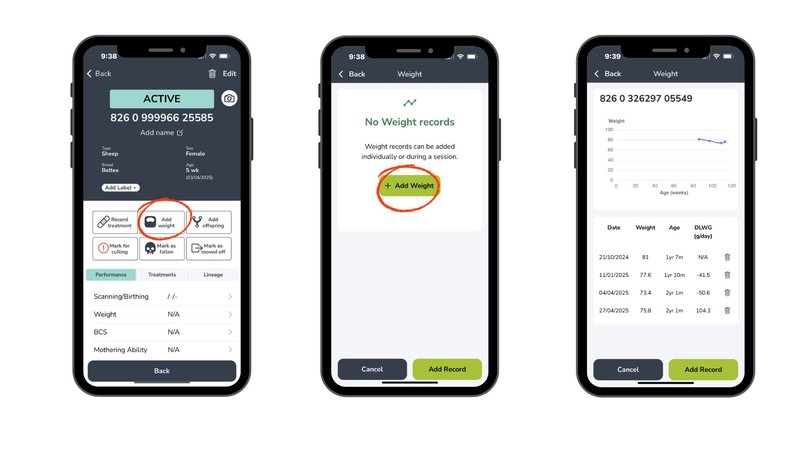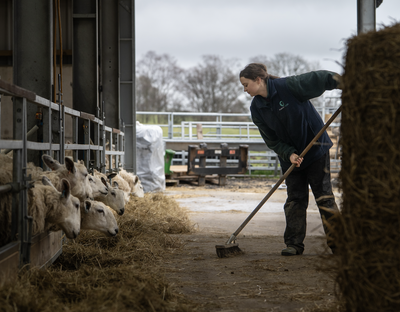🐑 What Should a Lamb Weigh at 8 Weeks?
The ideal 8-week weight for a lamb varies by breed and system, but a commonly accepted target is around 20–25kg for commercial lowland flocks. Hill breeds will naturally be lighter.
This equates to roughly 300–350g/day of average daily gain (ADG) from birth — a healthy, steady rate that keeps lambs on track for finishing or replacement selection.
✅ How much weight should a lamb gain per week?
Around 2.1 to 2.5kg/week is expected in well-fed, healthy lambs with good mothering.
🍼 Feeding and Growth: What Else Affects 8-Week Weights?
By 8 weeks, lambs are still drinking milk but also eating increasing amounts of grass.
- How much should an 8-week-old lamb drink?
They can still consume 1–1.5 litres/day of milk, but that begins dropping as they graze more. - What age do lambs start eating grass?
Most start nibbling around 2–3 weeks, and by 6–8 weeks, grass forms a major part of their intake.
🌱 What is fattening feed for sheep?
High-quality grass, clover-rich pasture, or supplementary creep feed help support optimal early growth.
📋 The Power of Early Weights in FlockFinder
By uploading your 8-week weights into FlockFinder, you:
- Track lamb performance against growth targets
- Identify ewes consistently producing poor growers
- Build up a picture of each animal’s value ahead of culling analysis
- Prepare better for weaning and finishing
And with tools like DLWG tracking, custom views, and culling reports, FlockFinder turns data into action — helping you make confident decisions come autumn.

⚖️ How to Weigh and What to Watch For
How do you calculate lamb weight?
The most accurate method is using a digital scale. Estimating by eye or girth band can work in a pinch, but frequent, proper weighing gives better results.
- How often should you weigh lambs?
Most farmers weigh at birth, again at 8 weeks, and then monthly or before weaning.
🧮 FlockFinder makes this process seamless — tag lambs, record weights, and automatically calculate daily live weight gain (DLWG). You can even view performance by sire, dam, or litter size.
Recording Weights in FlockFinder
Capturing 8-week weights is valuable — but turning that data into action is where the real impact lies. FlockFinder makes it easy to track growth over time and build a clear performance picture for every lamb.
Here’s how to log lamb weights and make the most of that data:
- Head to the Livestock tab
Start by opening the Livestock section on your FlockFinder dashboard. This is where all your animals live — neatly organised and searchable. - Select the lamb you want to weigh
Use filters or the search bar to find the lamb you’re recording for. You can sort by tag number, birth date, or dam ID to speed things up. - Click the “Add Weight” button
On the lamb’s profile, hit “Add Weight”. This brings up a form where you can enter the weight and the date of weighing.
- Input the weight data
Enter the lamb’s current weight (in kg) and the date it was taken. If you're using a Bluetooth-connected scale, the weight can pull through automatically. - View the data on the lamb’s weight chart
Once added, the weight will appear instantly on that lamb’s personal growth chart. You’ll see how this figure compares to earlier (or future) weights — a visual cue to track progress at a glance. - Record weights regularly to spot trends
The more data you collect, the clearer the picture. We recommend weighing lambs every few weeks through to weaning. This helps you monitor DLWG (Daily Live Weight Gain), identify any that are falling behind, and flag ewes that might not be pulling their weight in the flock.

It’s that simple — just a few clicks, and your flock’s performance is clearer than ever.
Capturing 8-week weights is one thing — making them useful is another. That’s where FlockFinder comes in.
With just a few taps, you can:
- ✅ Record weights directly to each lamb’s profile in seconds
- 📈 Automatically calculate DLWG (Daily Live Weight Gain)
- 🔍 Group and compare lambs by birth type (singles, twins, triplets), dam ID, or sire
- 🧠 Spot patterns that might flag high- or low-performing ewes
- 📊 Export reports to share or save for your culling analysis in autumn
By keeping this data updated, you're not just weighing for the sake of it — you're building a case for smarter culling, breeding selection, and market timing. Come autumn, when it's time to make those harder decisions, you'll be glad you had the numbers to back them.
📊 Why 8-Week Weights Matter for Culling Later
Here’s the key: What you record now determines what you keep later.
- Lambs with poor growth may reflect underperforming ewes
- Comparing singles, twins, and triplets helps set realistic benchmarks
- Uploading weights into FlockFinder enables smarter Culling Analysis later in the year
💡 Pro tip: Our “DLWG by litter size” view lets you compare lamb growth across different ewe performances — highlighting animals that might need replacing at tupping time.
🍼 Weaning and Growth: What’s the Right Timing?
- What’s the ideal weight to wean a lamb?
Weaning is often done around 30–35kg or 12–14 weeks, but can happen sooner with strong lambs. - Can you wean a lamb at 8 weeks?
It’s possible but not ideal unless feed and growth rates are exceptional. Earlier weaning increases stress and reduces rumen development. - When to wean lambs born in April?
Typically late June to mid-July, depending on performance and pasture condition. - What is the weaning rate for sheep?
That refers to number of lambs weaned per ewe — and it’s something FlockFinder helps track alongside weight and survival. - How do you calculate adjusted weaning weight?
By accounting for age at weighing and adjusting growth rates to a common standard — something FlockFinder automates so you don’t have to.
🐑 Common Weight-Related Questions
- How big is a 1-month-old lamb?
Around 10–15kg, depending on breed and nutrition. - How much does a 2-month-old lamb weigh?
Typically 20–25kg if gaining well. - How much does a 1-year-old sheep weigh?
Depending on breed, usually 60–90kg for mature females. - What is the ideal birth weight for a lamb?
About 4–6kg for most lowland breeds. - How do I tell if a sheep is overweight?
Use Body Condition Scoring (BCS) — 3.0 is ideal for most ewes mid-season. - What is the average weight of sheep in kg?
Adult ewes average 60–80kg, but this varies widely by breed. - How do you increase sheep weight?
Improve nutrition, monitor parasite load, and ensure mineral balance — all of which you can log and track with FlockFinder.
✅ Conclusion: 8 Weeks In, the Future’s Already Taking Shape
That first lamb weigh-in isn’t just a mid-season check — it’s the start of the most important records you'll collect all year.
Knowing how your lambs are doing at 8 weeks sets you up for better weaning, tupping, and culling decisions — and keeps your system accountable.
Use the tools in FlockFinder to log those weights, see trends, and make the most of every data point — so you're not just farming harder, but smarter.







